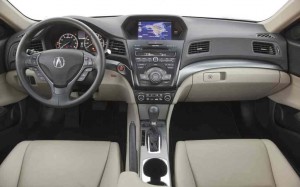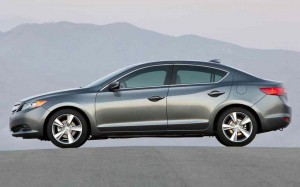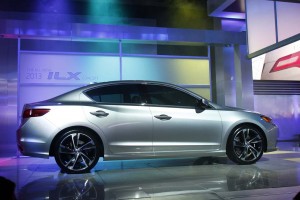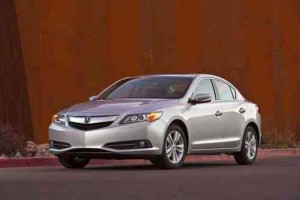It can be a challenge to explain Acura to those unfamiliar with the brand – perhaps the reason why it has slipped under the radar for so many potential buyers. The first of the Japanese luxury brands, the Honda division quickly earned a reputation for style and sportiness with products such as the original Legend flagship and the smaller Integra.
But, in a head-scratching move, Acura responded to newcomers Lexus and Infiniti by abandoning those well-known nameplates in favor of indistinguishable alphanumeric designations. Worse, all too many of its products became dull and lackluster, sales tumbling in response.
To its credit, Acura has finally recognized the errors of its way. And while it has yet to finally abandon the naming strategy, which leaves motorists struggling to determine the difference between an RL, TL and RLX, it has toned down the ungainly “beak” grille. Now, more importantly, it is also fleshing out a thin line-up, adding the new “flagship” RLX and, at the other market extreme, the 2013 Acura ILX.
The new entry model slots beneath the older Acura TSX and is clearly aimed at a new generation of Millennial buyers, Acura officials explaining their goal of bringing first-time luxury customers into the brand where, the maker hopes, they’ll stick around, migrating ever upwards as they grow older. The new Acura ILX includes the requisite high-tech features, including an updated infotainment system that can operate some of the more popular smartphone apps, such as Pandora.
But as we headed to Phoenix, recently, we were looking to see how the 2013 ILX might fare when measured on more traditional automotive attributes.
As earlier noted, Acura has finally heeded critics, shrinking the clumsy silver beak that has been an unpleasantly distinguishing feature on so many other recent models. What worried us was a comment made to TheDetroitBureau.com during a secret background meeting, last autumn, suggesting that the brand was planning to tone down its overall approach to styling. Quite the opposite is needed.

Though based on the Honda Civic platform the ILX shares none of the mainstream car's switches or dials.
Yet, while the 2013 Acura ILX is a reasonably handsome product, it is clear that the maker did, indeed, take a generally cautious approach – almost the antithesis of what we’re seeing from a key competitor in the form of the very aggressively styled Lexus GS and Toyota Avalon remakes.
The ILX is built up from the foundation of the latest Honda Civic – itself roundly criticized for playing it safe. But while the two cars bear a subtle resemblance, the ILX is anything but a clone of its down-market cousin. Fittingly, for a luxury brand, Acura designers give the new sedan the appearance of a much longer front end, for one thing.
What’s interesting are some of the tricks they used to create that look. The A-pillars, for example, were pushed back almost 8 inches, even though the base of the windshield receded just 4 inches. That approach necessitates some serious curves to the ILX front glass.

The Acura ILX Hybrid makes great mileage numbers but the 11.2 second launch time isn't nearly as impressive.
Like so many other recent designs, the influence of the wind tunnel is readily apparent, including the tall rear deck that keeps the wind flowing smoothly over the length of the ILX body. The side benefit comes with the tall and seemingly muscular rear shoulders.
The latest Civic took quite a bit of heat for corner-cut interior details, especially with the use of lots of cheesy-looking plastic. Not so with the Acura ILX. While it certainly doesn’t reach the level of refinement of the new RLX – which will likely come in at about twice the $26,795 base price of the entry-lux sedan – you know immediately that you’re in a luxury car.
There isn’t a single holdover Civic switch or dial. There is the big knob anchoring the center stack that Acura has long been using to control its infotainment system. As with everything from BMW’s iDrive to Audi’s MMC, such controls seem to always generate controversy. But our own experience suggests the learning curve for the Acura system is about as short as you can get.
The new ILX is offered in three configurations, the high-volume model being powered by a 2-liter inline-four making 150 horsepower and 140 lb-ft of torque. Disappointingly, Acura sticks with a 5-speed automatic, even though a number of down-market brands are migrating to 6-, 7-, even 8- and 9-speed gearboxes.
For those looking for a sportier ride, there’s a 2.4-liter I-4 making 201 hp and 170 lb-ft. It come exclusively with a 6-speed manual – the only model in the ILX line-up to offer a stick, in fact.
At the other extreme, green-minded buyers might be tempted by the ILX Hybrid, which makes use of the latest version of Honda’s IMA, or Integrated Motor Assist gas-electric driveline. That includes Stop/Start, which automatically shuts off the engine rather than wasting gas idling at a light or fast food drive-through. Lift your foot off the brake and the engine automatically fires back up.
It may boost your mileage to 39 City/38 Highway — not an issue to ignore with fuel prices hovering near record levels — but at just 111 hp and 127 lb-ft, we found the hybrid to be a bit on the anemic side. Honda claims a pokey 11.2 seconds 0 to 60.
The base engine’s performance isn’t exactly spirited but it is a reasonably responsive package that will let a buyer keep up with traffic and won’t force you to cover your face when you launch off the stoplight. But there’s no question that the 2.4-liter engine is the powertrain package of choice if you like your vehicle fun-to-drive.
As with the basic platform, Acura engineers have adapted and updated the Honda Civic strut/multilink suspension, adding an “amplitude reactive damping” system, another way to say a two-stage shock absorber. But it introduces a technically slick way to handle varying road conditions and driver demands than the traditional multi-stage shock, something that impressed us during drives through the mountains outside Phoenix. Great at masking harsh road bumps it firms up nicely during high-speed cornering.
On the downside, we found the ILX interior a bit noisy, especially on rougher pavement.
More positive was our reaction to the electric power assist steering, which is a bit firmer than Civic’s, and notably less numb than some other EPAS systems in the entry-lux sedan segment.
In terms of the functional niceties, the seats are comfortable and reasonably supportive, the 2013 Acura ILX offering a reasonable amount of interior space but just 12.4 cubic feet of cargo space – a bit on the low side for the segment. It offsets minimal storage space in the doors and center console with an extremely large glovebox.
Acura’s move into the entry-lux market makes sense considering current market trends. Not only does the maker hope to appeal to those first-time Millennial buyers but also to Baby Boomers who might need something smaller as their own kids move away.
Of course, the maker isn’t the only one reading the tea leaves for market trends and there’s plenty of company in the segment, including the likes of the BMW 1-Series, the upcoming Audi A3 remake, the new Buick Verano, Mercedes’ planned A-Class and the Cadillac ATS coming later this year.
And that’s where Acura’s strategy could run into trouble, considering the $26,795 to $35,295 range for the 2013 ILX. It’s at best mid-segment, the Verano listing for roughly $3,000 less. And then there’s the TSX, which a buyer could get into for less than $1,000 more than an ILX. The TSX delivers better performance, more room and some additional features.
Nonetheless, we expect the new Acura ILX to find a niche in the market, especially if Acura can find the marketing language to speak to a new generation of buyers.





